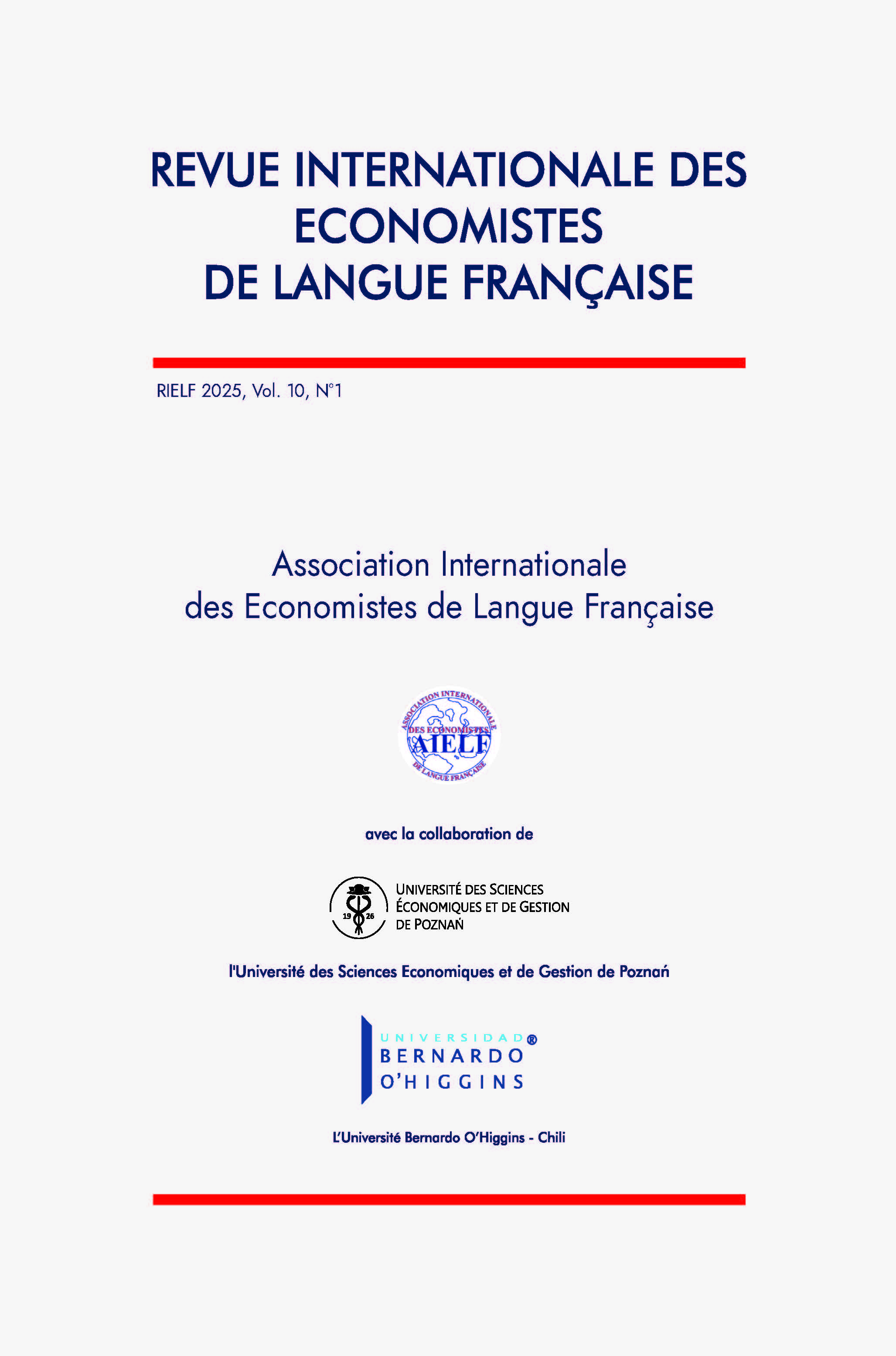Dollarization sustainability in Lebanon
DOI:
https://doi.org/10.18559/rielf.2025.1.2447Keywords:
dollarization, exchange rate regime, central bank, LebanonAbstract
Purpose - The objective of this article is to identify the dollarization process that began in Lebanon with the hyperinflation and the strong depreciation of the eighties and which reflects an inertia, or even an acceleration with the multidimensional crisis that the country has been experiencing since October 2019. Following the normalization of the current situation thanks to a dollarization that has become almost complete and almost official, the main question that arises concerns the factors of sustainability and sustainability of a possible complete officialization of dollarization.
Design/methodology/approach – The paper adopts an evaluative research approach to explain the determinants of the irreversibility of dollarization with an addiction to the US dollar, to highlight the necessary factors of sustainability of full official dollarization, and to specify the key structural reforms that could be necessary for the sustainability of dollarization in Lebanon. The research methodology is based on a philosophy oriented towards post-positivism and a hypothetico-deductive research approach where the hypothesis can be deduced from an already formulated theory, from previous works or deduced by analogy.
Findings – The results show that the success of full dollarisation requires the achievement of a range of monetary, budgetary, legislative conditions requiring a national consensus and comprehensive reforms.
Originality/value – The main value of the work with the opening of the debate on dollarization in the Lebanese parliament allows to visualize the conditions of its success beforehand especially since it is an irreversible process and to draw the necessary lessons for any other country experiencing a similar experience.
JEL Classification
Central Banks and Their Policies (E58)
Downloads
References
Aglietta, M., & Orléan, A. (1995). Souveraineté, légitimité de la monnaie. Association d’Économie Financière.
View in Google Scholar
Ares, M. (2001). A quand le règne du dollar ? Instabilité économique, crise politique et intégration monétaire dans les Amériques. Études Internationales, 32, 747–772.
View in Google Scholar
Atallah, S. (2023). The increasing role and importance of remittances in Lebanon. United Nations Development Programme.
View in Google Scholar
Bank of Iceland. (2005). Analysis of net errors and omissions. 32nd Meeting of the IMF Committee on Balance of Payments Statistics.
View in Google Scholar
Berg, A., Borensztein, E., & Mauro, P. (2002). An evaluation of monetary regime options for Latin America. The North American Journal of Economics and Finance, 13(3), 213–235.
View in Google Scholar
Bitar, J. (2022). Monetary and macroprudential policies in a dollarized economy: The case of Lebanon [doctoral dissertation]. Université de Bordeaux.
View in Google Scholar
Bourguinat, H., & Dohni, L. (2002). La dollarisation comme solution en dernier ressort. Revue Française d’Économie, 1(17), 57–96.
View in Google Scholar
Calvo, G. A. (1999). Testimony on full dollarization. University of Maryland.
View in Google Scholar
Catão, L. A. V., & Terrones, M. E. (2016). Financial de-dollarization: A global perspective and the Peruvian experience. International Monetary Fund.
View in Google Scholar
Chim, P. R. (1999). Migration, informalité transfrontalière et paradoxe de l’intégration entre PVD: La région des Caraïbes. Canadian Journal of Development Studies/Revue Canadienne d’Études du Développement, 20(1), 127–158.
View in Google Scholar
Dagher, A. (2024). La crise financière du Liban. Taux de change, FMI, politique monétaire. Cambridge Journal of Economics, 29, 927–941.
View in Google Scholar
Eichengreen, B. (2002). When to dollarize. Journal of Money, Credit and Banking, 34(1), 1-24.
View in Google Scholar
Farah, F & Maucourant J. (2021, 22 octobre). Liban: Capitalisme, État et pouvoir en crise. Analyse Opinion Critique.
View in Google Scholar
Hausmann R., Panizza U., Reinhart C. M., Barrios, D., Brenot, C., Pacheco, J. D., Luckner, C. von, Muci, F., & Venturi, L. (2023). Towards a sustainable recovery for Lebanon’s economy. Center for International Development at Harvard University.
View in Google Scholar
Hofstee, E. (2006). Constructing a good dissertation: A practical guide to finishing a master’s, MBA or PhD on schedule. EPE.
View in Google Scholar
Honda, J., & Schumacher, L. B. (2006). Adopting full dollarization in postconflict economies: Would the gains compensate for the losses in Liberia? IMF Working Paper, 06/82. https://papers.ssrn.com/Sol3/papers.cfm?abstract_id=901873
View in Google Scholar
Jácome, M. L. I., & Lönnberg, Å. (2010). Implementing official dollarization. International Monetary Fund.
View in Google Scholar
Kamel, D. (2023, May 2). Lebanon to get $9bn cash boost from 2.2 million visitors in 2023, minister says. https://www.thenationalnews.com/business/travel-and-tourism/2023/05/02/lebanon-to-get-9bn-cash-boost-from-22-million-visitors-in-2023-minister-says/
View in Google Scholar
Lebanon Ministry of Finances. (2022). Debt and debt markets reports.
View in Google Scholar
Lupupa, J. (2003). Dollarization and sustainability in emerging markets : Lessons from Ecuador and Bolivia. https://ruor.uottawa.ca/server/api/core/bitstreams/688ca9f1-b0c8-46cb-b090-232acc5dcdcf/content
View in Google Scholar
Malingumu, C. (2015). Dedollarisation de l’économie congolaise: Atouts, contraintes et perspectives. MPRA Paper, 81932. https://mpra.ub.uni-muenchen.de/81932/1/MPRA_paper_81932.pdf
View in Google Scholar
Mueller, M. J. (1994). Dollarization in Lebanon. International Monetary Fund.
View in Google Scholar
Mundell, R. A. (1961). A theory of optimum currency areas. The American Economic Review, 51(4), 657–665.
View in Google Scholar
Ponsot, J. F. (2019). Économie politique de la dollarisation. Mondes en Développement, 188(4), 51–68.
View in Google Scholar
Ponsot, J. F., & Rizkallah, S. (2024). Dollarization in Lebanon. International Journal of Political Economy, 53(4), 473–491.
View in Google Scholar
Rizkallah, S. (2022). L’indépendance de la BDL et les déterminants de la crise économique au Liban. Revue Internationale des Économistes de Langue Française, 7(2), 9–31.
View in Google Scholar
Roubini, N. (2021). Factors to be considered in assessing a country’s readiness for dollarization. Stern School of Business.
View in Google Scholar
World Bank. (2020). Lebanon subsidy reform note. World Bank Group.
View in Google Scholar
World Bank. (2022, fall). Time for equitable banking resolution. Lebanon Economic Monitor.
View in Google Scholar
World Bank. (2023, spring). The normalization of crisis is no road for stabilization. Lebanon Economic Monitor.
View in Google Scholar
Downloads
Published
Issue
Section
License
Copyright (c) 2025 Jean-Francois Ponsot , Siham Rizkallah

This work is licensed under a Creative Commons Attribution-NonCommercial-ShareAlike 4.0 International License.





